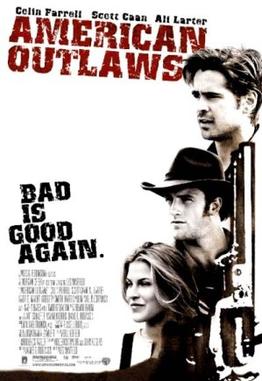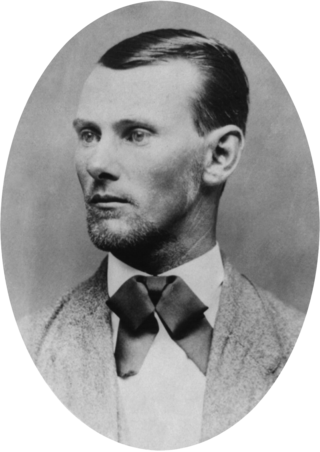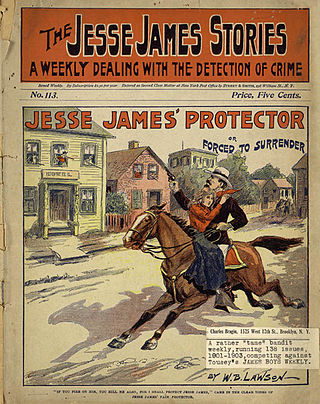
Northfield is a city in Dakota and Rice counties in the State of Minnesota. It is mostly in Rice County, with a small portion in Dakota County. The population was 20,790 at the 2020 census. Northfield is 40 miles south of the downtowns of Minneapolis and St. Paul and is an exurb of the Minneapolis-St. Paul metropolitan area.

Alexander Franklin James was a Confederate soldier and guerrilla; in the post-Civil War period, he was an outlaw. The older brother of outlaw Jesse James, Frank was also part of the James–Younger Gang.

Since the invention of locomotives in the early 19th century, trains have often been the target of robbery, in which the goal is to steal money or other valuables. Train robbery was especially common during the 19th century and is commonly associated with gangs of outlaws in the American Old West. It has continued into the 21st century, with criminals usually targeting freight trains carrying commercial cargo, or targeting passengers of public transportation for their valuables.

The James–Younger Gang was a notable 19th-century gang of American outlaws that revolved around Jesse James and his brother Frank James. The gang was based in the state of Missouri, the home of most of the members.

Thomas Coleman Younger was an American Confederate guerrilla during the American Civil War and later an outlaw leader with the James–Younger Gang. He was the elder brother of Jim, John and Bob Younger, who were also members of the gang.

Robert Ewing Younger was an American criminal and outlaw, the younger brother of Cole, Jim and John Younger. He was a member of the James–Younger Gang. He stood six feet, two inches tall and had deep blue eyes, muscular arms, and a thick neck.

James Hardin Younger was an American outlaw and member of the James–Younger Gang. He was the brother of Cole, John and Bob Younger.

The Long Riders is a 1980 American biographical Western film directed by Walter Hill. It was produced by James Keach, Stacy Keach and Tim Zinnemann and featured an original soundtrack by Ry Cooder. Cooder won the Best Music award in 1980 from the Los Angeles Film Critics Association Awards for this soundtrack. The film was entered into the 1980 Cannes Film Festival.

Robert Newton Ford was an American outlaw who killed fellow outlaw Jesse James on April 3, 1882. He and his brother Charley, both members of the James–Younger Gang under James's leadership, went on to perform paid re-enactments of the killing at publicity events. Ford went on to operate various saloons and dance halls in the West, before being killed – at age 30 – by Edward Capehart O'Kelley in Creede, Colorado.

Joseph Lee Heywood was the acting cashier at the First National Bank of Northfield, Minnesota, when the James-Younger Gang attempted to rob the bank. At the time, Heywood also held positions as Treasurer for the City of Northfield and Treasurer of Carleton College.

American Outlaws is a 2001 American Western action film directed by Les Mayfield and starring Colin Farrell, Scott Caan, and Ali Larter.

Frank and Jesse is a 1994 American biographical Western film written and directed by Robert Boris and starring Rob Lowe as Jesse James and Bill Paxton as Frank James. Based on the story of Jesse James, the film focuses more on myths of The James Brothers than the real history. It originally aired on HBO.

Clell Miller was an outlaw with the James-Younger Gang who was killed during the gang's robbery at Northfield, Minnesota.

Nicholas Gustafson was a Swedish immigrant who was mortally wounded in the James–Younger Gang bank raid in Northfield, Minnesota. Various sources use alternate spellings of his names including Nicolaus, Nicholaus or Niclas and Gustavson. He was born near Fiddekulla in the parish of Vissefjärda in Kalmar, Sweden.

The True Story of Jesse James is a 1957 American Western drama film adapted from Henry King's 1939 film Jesse James, which was only loosely based on James' life. It was directed by Nicholas Ray, with Robert Wagner portraying Jesse James and Jeffrey Hunter starring as Frank James. Filming took place during 1955. Originally titled The James Brothers in the United Kingdom, the film focused on the relationship between the two James brothers during the last 18 years of Jesse James' life.

Jesse Woodson James was an American outlaw, bank and train robber, guerrilla and leader of the James–Younger Gang. Raised in the "Little Dixie" area of Missouri, James and his family maintained strong Southern sympathies. He and his brother Frank James joined pro-Confederate guerrillas known as "bushwhackers" operating in Missouri and Kansas during the American Civil War. As followers of William Quantrill and "Bloody Bill" Anderson, they were accused of committing atrocities against Union soldiers and civilian abolitionists, including the Centralia Massacre in 1864.

The Younger Brothers is a 1949 American Western film directed by Edwin L. Marin and starring Wayne Morris, Bruce Bennett, Janis Paige.

The Great Missouri Raid is a 1951 American Western released by Paramount Pictures starring Wendell Corey, Macdonald Carey, and Ward Bond, with Ellen Drew, Bruce Bennett, Bill Williams and Anne Revere in support. It was directed by Gordon Douglas and written by Frank Gruber.

Cultural depictions of Jesse James appear in various types of media, including literature, video games, comics, music, stage productions, films, television, and radio. James is variously described as an American outlaw, bank and train robber, guerrilla, and leader of the James–Younger Gang. After the American civil war, as members of various gangs of outlaws, Jesse and Frank James robbed banks, stagecoaches, and trains across the Midwest, gaining national fame and even sympathy despite their crimes. James became an iconic figure from the era, and his life has been dramatized and memorialized numerous times.
The Gads Hill Train Robbery was a crime committed by the James–Younger Gang in Gads Hill, Missouri. In January 1874, five members of the James–Younger gang robbed a train and stole $12,000 in cash. All five escaped.



















